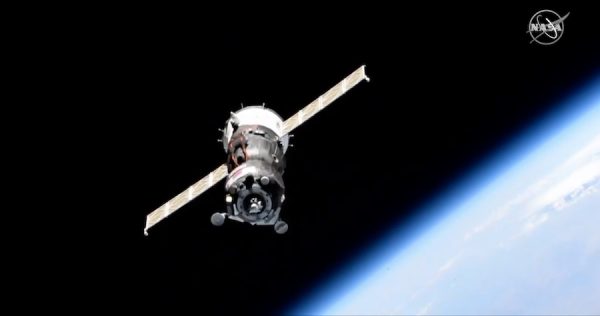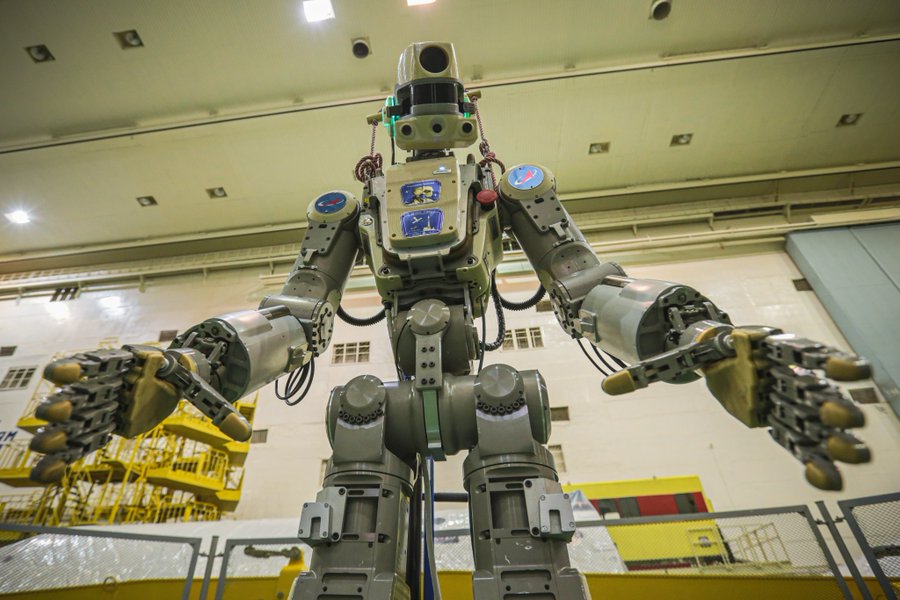Soyuz docking aborted at International Space Station – Spaceflight Now

Russian cosmonauts aboard the International Space Station commanded an approaching unpiloted Soyuz spacecraft to abort its docking Saturday after the ship’s automated rendezvous system ran into trouble, leaving ground teams assessing what went wrong and whether to attempt another link-up in orbit.
The Soyuz MS-14 spacecraft, flying on a test mission without a crew, was set to dock with the International Space Station’s Poisk module at 1:30 a.m. EDT (0530 GMT) Saturday.
After a smooth two-day trek from a launch pad in Kazakhstan, the Soyuz spaceship tried to lock on to its docking target on the station as it loitered roughly 330 feet (100 meters) away Saturday.
But the Soyuz spacecraft’s Kurs rendezvous radar was unable to lock on to the station docking port, and live video from space showed the Soyuz capsule oscillating side-to-side, apparently trying to find its target. Two Russian cosmonauts monitoring the Soyuz spaceship’s docking attempt inside the space station temporarily lost sight of the approaching capsule in video monitors, prompting Russian ground controllers operating in Korolev, near Moscow, to ask the crew to search for the craft through windows.
Meanwhile, NASA flight controllers in Houston informed the U.S. and European crew members on the station of the Soyuz docking difficulties.
“We just want to let you know the Kurs is having difficulty locking on to the target and we wanted to make sure you’re awake,” flight controllers in Houston radioed the station’s other four crew members. “And you have a go to open windows for situational awareness as needed.”
“Copy,” astronaut Christina Koch replied. “Thank you. Any crew action on our part needed at this time?
“No crew action.”
The Soyuz MS-14 spacecraft is the first Russian crew ferry ship to fly without any cosmonauts on-board in 33 years. Russian space officials ordered the unpiloted test flight to verify the spacecraft’s compatibility with the upgraded Soyuz-2.1a booster, which will replace an older Soyuz rocket model for crew launches beginning next March.
On the unpiloted test flight, the Soyuz MS-14 spacecraft can only dock with the station in automatic mode, using inputs from a Kurs rendezvous radar feeding range, closure rate and other data to the ship’s on-board computer.
There is no cosmonaut abroad to take manual control, as would be the case on a typical Soyuz mission. The Soyuz MS-14 is also not outfitted with the TORU system, which flies on Progress cargo freighters, allowing cosmonauts inside the space station to take remote control of the spacecraft for docking if necessary, using a video feed from the approaching vehicle for cues.
After the Soyuz failed to lock on to its docking target, the only option left available was for cosmonauts Alexander Skvortsov and Alexey Ovchinin to send an abort command to the Soyuz spacecraft.
“Alexander, you are go to send command CS-47,” Russian mission controller instructed station cosmonaut Alexander Skvortsov.
“CS-47 has been sent,” the crew replied.
“Station, Houston on 2, Soyuz is aborting,” NASA mission control told the crew.
Live video from the space station showed the Soyuz MS-14 spacecraft backing away, and ground teams soon confirmed the Soyuz was a safe distance from the station.
“The decision has been made by Russian flight controllers not to attempt another rendezvous tonight,” said Rob Navias, mission control commentator at the Johnson Space Center in Houston.
“It is unclear as to what the next course of action might be as the Russian flight control team assesses what may have caused a problem with the Kurs automated rendezvous system,” Navias said. “But the Soyuz has now backed away to a safe distance. At no time was the crew in any danger.”
A few minutes later, Russian ground controllers told Skvortsov and Ovchinin that the next opportunity to dock the Soyuz with the space station will be no earlier than Sunday night or Monday morning. Officials did not announce an exact target docking time.
“Obviously, we’ve got a lot of investigating to do,” a Russian flight director told the station crew.
Russian engineers believe a problem with an amplifier associated with the the passive Kurs system on the space station led to the abort of Saturday’s docking attempt. The passive segment of the Kurs system is supposed to link with the active radar on the Soyuz.
Mission controllers in Moscow planned to send up instructions for the cosmonauts to swap Kurs amplifiers on the station and run a test to determine if that system was responsible for Saturday’s rendezvous woes.
“It’s such a shame we were not able to use TORU,” one of the station cosmonauts said. “We would grab it and bring it in.”
The possibility of another docking attempt Sunday night or Monday morning hinges on resolving the Kurs rendezvous system failure.

The lack of a crew on the Soyuz MS-14 spaceship allowed ground teams to pack some 1,450 pounds (657 kilograms) of cargo inside the spacecraft. The Russian Skybot F-850 robot, a two-legged, two-armed humanoid stand-in for a cosmonaut commander, is strapped into the Soyuz center seat.
The Skybot F-850 is not designed to manipulate any flight controls during the Soyuz mission, but sensors on the robot’s body are measuring key parameters — such as acceleration, vibrations, temperature and humidity — during the flight, including launch, docking and landing.
Alexander Bloshenko, a science advisor at Roscosmos, said the Skybot F-850 robot will conduct experiments at the space station prepared by Russian engineers.
Skvortsov plans work with Skybot F-850 after it arrives at the station. Skvortsov will be able to communicate with the robot, according to Roscosmos.
Cosmonauts will move Skybot F-850 into the space station for five days of experiments and tests, before returning the robot to the Soyuz capsule for the trip back to Earth, according to Navias.
Measuring nearly 6 feet (1.8 meters) tall and weighing about 350 pounds (160 kilograms), Skybot F-850 will replicate the movements of Skvortsov during a series of tests in orbit. If the tests are successful, Russia could launch upgraded robots that could work outside the space station, helping crews with tasks on spacewalks, or allowing cosmonauts to avoid spacewalks altogether, Bloshenko said.
The Skybot F-850 robot is an evolution of Russia’s FEDOR series of robots, which engineers originally developed for rescue operations. Videos from ground testing have shown the FEDOR robot shooting guns, lifting weights and driving a car.
The Russian Foundation for Advanced Research Projects, with a role similar to DARPA in the U.S. government, led the development of the FEDOR robot. FEDOR stands for Final Experimental Demonstration Object Research.
Assuming the Soyuz eventually links up with the space station, the spaceship — with Skybot F-850 — is scheduled to undock from the complex early next month for a return home to land in Kazakhstan. Before Saturday’s aborted docking attempt, the Soyuz MS-14 spacecraft’s departure and landing were set for Sept. 6.
Email the author.
Follow Stephen Clark on Twitter: @StephenClark1.






